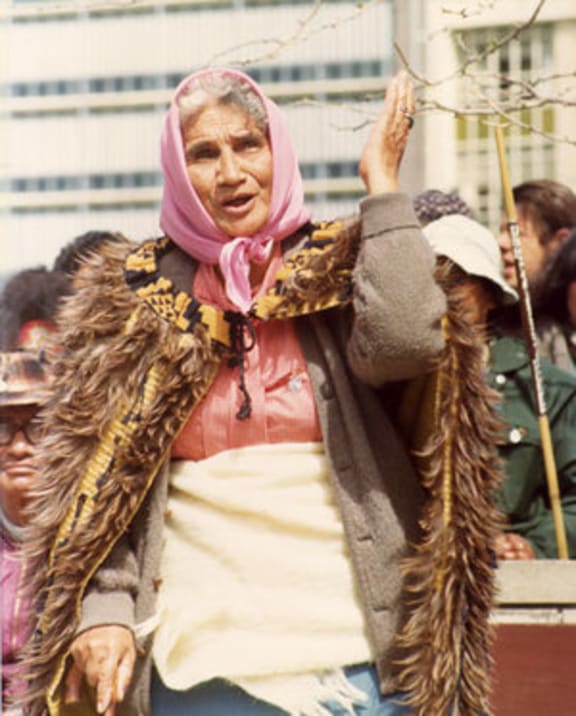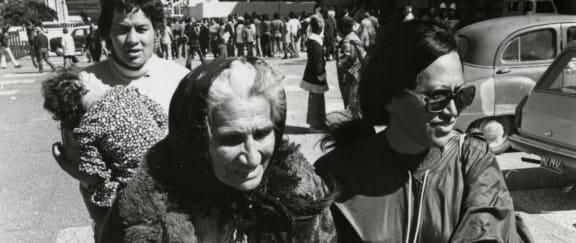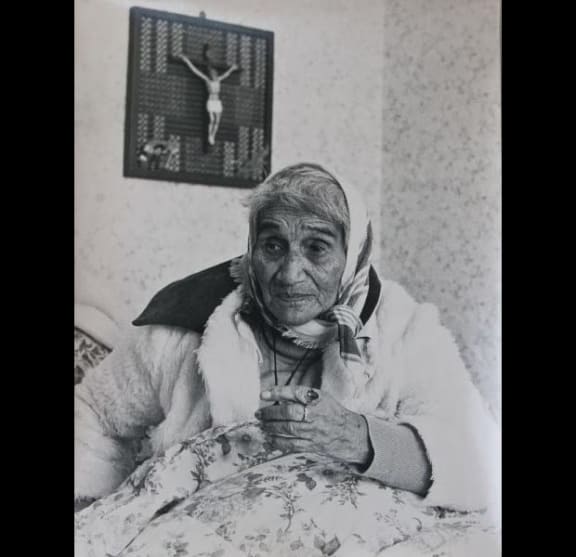Dame Whina Cooper was considered by many to be the most determined woman in the country for her leadership in bringing to the country's attention the loss of Māori land ownership. She led Te Matakite, the first big hikoi in 1975 from Te Hāpua in the far North to the steps of Parliament in Wellington, covering more than 1054 kilometres.
The hikoi presented a memorial of rights, asking the state to preserve the mana and tūrangawaewae of the Māori people. Dame Whina was 80, and despite being frail, she led from the front and she demanded to be listened to. And obeyed.
Like Dame Whina, the former chief executive of Te Taura Whiri, the Māori language commission, Haami Piripi, is of Te Rarawa descent.
Dame Whina led the hikoi from Te Hapua with her 3-year-old mokopuna’s hand in hers.
“From there, you could be considered to be leaving the tip of the island to travel - the tail of the fish, to travel to the head of the fish.”
Piripi says he was only a young chap when Dame Whina was an old woman.
“I sat at her feet many times listening to her speak, she was an orator of equal to any man.”
He participated in the land hikoi as a teenager and says he had a lot of do with her over the years.
“As she got older she attended Waitangi annually and was able to express her views and her understanding that she had come to in the length of her life and the experiences that she had had in her life.”
In her early years, Dame Whina entertained prime ministers and ministers in her home, an amazing feat in itself, says Piripi.
“It showed you how much mana and prestige she had with them and probably because of the nature of her leadership, forcefulness of her personality and the insightfulness of her intellect. She was a very insightful person.”
She had a combination of genealogy, leadership training, support from the leadership and had her schooling sponsored, he says.
“She was the person that galvanised all the array of different issues, opinions, claims, angsts that different communities had had around alienation of land, loss of authority and she really encapsulated that into the march and the term not one more acre.”
It’s a term that’s used today by many Māori communities who are trying to hold onto their land as kaitiakitanga says Piripi.
Dame Whina at the time of her 1975 hikoi said she had every hope that the Pākehā would listen.
“Good gracious, it’s our land…of course they will, I have every hope that the Pākehā would.
“We want all of the statutes, all of the laws that are pertaining to taking our land little by little at the time, to be wiped right off and let us retain the 2 million, only 2 million that is left out of 66 million,” she said.
Piripi says Māori rallied to the call of ‘not one more acre’.
“You could really put it down to that point in our history where there was a conscious movement by Māori land owners to hold onto our land.”
He says there was an understanding by the authorities that it wasn’t an appropriate way to acquire land.
“At that stage they were taking land for non payment of rates and all sorts and lots and lots of land was lost in that way.”
It was the last taking of the land on mass, he says.
“Now of course we’re focused on land use and bringing some kind of productivity to land.”
Piripi says as the hikoi moved down the country, it had the ability to gather grievances.
“It was in a way weaving a whole thread of injustice, as it were, down the country.”
When it reached Parliament, Dame Whina addressed Robert Muldoon in te reo Māori.
“By the time it got to Wellington, it was a well-woven thread of credibility and veracity and that’s why she had the ability to say…in her statement ‘you need to give us your answer because depending on your answer will determine how long we sit this out.”
It was an indication of the implications of not addressing matters properly, says Piripi.
“She really wanted things to be resolved as quickly as possible by the right people and whenever she could do that she was incisive and made sure she achieved that if not through someone she told what to do or something she did herself.”
The vision that Dame Whina had is the same vision that people are educated in, he says.
“The is the notion of a unified nation and when you have a united nation with a common cause and a collaborative population, you get amazing results.”
Piripi says perhaps what’s missing at Ihumātao right now is Dame Whina’s style of leadership and a commonality of purpose within iwi.
“Where someone could rise above everybody else with a rallying call that everyone could identify with.”
He says people within the iwi need to work together.
“There’s a whole new generation of young people now who are saying you old people, you didn’t fight hard enough, you didn’t recognise enough of the pain, of the grievance to be able to hold firm and be fast but we can’t judge, we can’t look back and judge…”
He says he hopes at Ihumātao the generations are able to sit down and mould their future together.
This story was produced using archival audio from Ngā Taonga Sound and Vision.

Photo: Nga Taonga Sound & Vision









